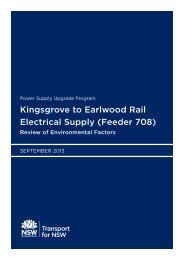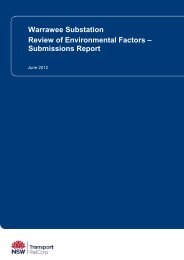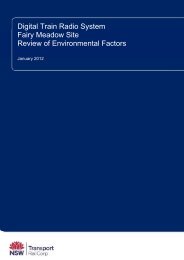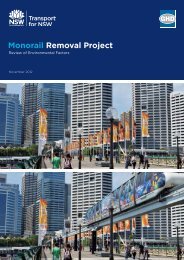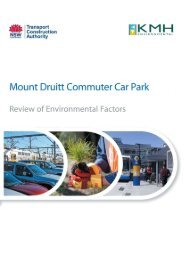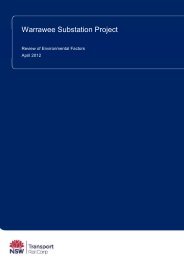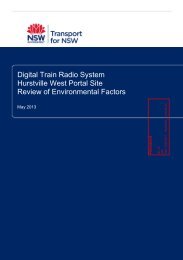Digital Train Radio System Como Site Review of Environmental ...
Digital Train Radio System Como Site Review of Environmental ...
Digital Train Radio System Como Site Review of Environmental ...
Create successful ePaper yourself
Turn your PDF publications into a flip-book with our unique Google optimized e-Paper software.
2 Statutory Position and Requirements<br />
The description <strong>of</strong> the proposed works and the associated environmental impacts have been<br />
undertaken in the context <strong>of</strong> Clause 228 <strong>of</strong> the <strong>Environmental</strong> Planning and Assessment<br />
Regulation 2000, the Threatened Species Conservation Act 1995 (TSC Act), and the<br />
(Commonwealth) Environment Protection and Biodiversity Conservation Act 1999 (EPBC Act).<br />
In doing so, this REF helps fulfil the requirements <strong>of</strong> Section 111 <strong>of</strong> the <strong>Environmental</strong> Planning<br />
and Assessment Act 1979 (EP&A Act), that RailCorp must examine and take into account to the<br />
fullest extent possible, all matters affecting or likely to affect the environment by reason <strong>of</strong> the<br />
activity. The legislative framework relevant to the proposed works and associated approvals is<br />
set out in the following sections.<br />
2.1 <strong>Environmental</strong> Planning and Assessment Act 1979<br />
The <strong>Environmental</strong> Planning and Assessment Act 1979 (EP&A Act) establishes the statutory<br />
framework for planning and environmental assessment in New South Wales. Implementation <strong>of</strong><br />
the EP&A Act is the responsibility <strong>of</strong> the Minister for Planning and Infrastructure, statutory<br />
authorities and local councils.<br />
The EP&A Act contains three parts which impose requirements for planning approval:<br />
• Part 3A provides for control <strong>of</strong> ‘major infrastructure and other projects’ that require approval<br />
from the Minister for Planning and Infrastructure;<br />
• Part 4 generally provides for the control <strong>of</strong> local ‘development that requires development<br />
consent from the local Council’; and<br />
• Part 5 provides for the control <strong>of</strong> ‘activities’ that do not require development consent and<br />
are undertaken or approved by a determining authority.<br />
The applicable approval process is generally determined by reference to the relevant<br />
environmental planning instruments and other controls. These include Local <strong>Environmental</strong><br />
Plans (LEP) and State <strong>Environmental</strong> Planning Policies (SEPPs). Pursuant to Section 36 <strong>of</strong> the<br />
EP&A Act there is a general presumption that a SEPP prevails over a LEP in the event <strong>of</strong> an<br />
inconsistency.<br />
As RailCorp is the determining authority and this site falls under the definition <strong>of</strong> activities that<br />
do not require consent, the approval <strong>of</strong> this site will be sought under Part 5 <strong>of</strong> the EP&A Act.<br />
2.2 State <strong>Environmental</strong> Planning Policy (Infrastructure) 2007<br />
The State <strong>Environmental</strong> Planning Policy (Infrastructure) 2007 (ISEPP) provides a consistent<br />
planning regime for infrastructure and the provision <strong>of</strong> services across NSW, along with<br />
providing for consultation with relevant public authorities during the assessment process.



